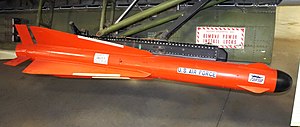
Back AIM-4 Falcon Bulgarian Hughes AIM-4 Falcon Czech AIM-4 Falcon German AIM-4 Falcon Spanish ایم-۴ فالکون FA AIM-4 Falcon Finnish AIM-4 Falcon French AIM–4 Falcon Hungarian AIM-4 Falcon ID AIM-4 Falcon Italian
| AIM-4 Falcon | |
|---|---|
 AIM-4D Falcon | |
| Type | Air-to-air missile |
| Place of origin | United States |
| Service history | |
| In service | 1956–88 (AIM-4F/AIM-4G) |
| Production history | |
| Manufacturer | Hughes Aircraft |
| Specifications | |
| Length | 1.98 m (6 ft 6 in) |
| Diameter | 163 mm (6.4 in) |
| Wingspan | 508 mm (20.0 in) |
| Warhead | 3.4 kg (7.5 lb) |
| Propellant | solid fuel rocket |
Operational range | 9.7 km (6.0 mi) |
| Maximum speed | Mach 3 |
Guidance system | semi-active radar homing and Tail-chase engagement infrared homing |

The Hughes AIM-4 Falcon was the first operational guided air-to-air missile of the United States Air Force. Development began in 1946; the weapon was first tested in 1949. The missile entered service with the USAF in 1956.
Produced in both heat-seeking and radar-guided versions, the missile served during the Vietnam War with USAF McDonnell Douglas F-4 Phantom II units. Designed to shoot down slow bombers with limited maneuverability, it was ineffective against maneuverable fighters over Vietnam. Lacking proximity fusing, the missile would detonate only if a direct hit was scored. Only five kills were recorded.
With the AIM-4's poor kill record rendering the F-4D ineffective at air-to-air combat, the fighters were modified to carry the AIM-9 Sidewinder missile instead, which was already carried on USAF F-4Cs, USN and USMC F-4 Phantom II and F-8 Crusader jet fighters. The Sidewinder was more effective in the fighter vs fighter role on the F-4 platform, and improved versions continue to serve the armed forces of the United States and numerous allied nations to this day.